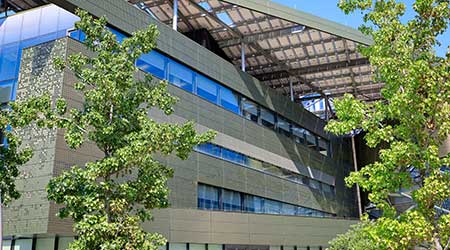LEED-CI Should Be Planned Early In Building Selection And Leasing
4. Cultural performance. The precepts of green building have been shown to support such intangibles as customer relations, internal camaraderie and personal work satisfaction. The Michigan State study shows that IAQ, daylighting and views to the outdoors correlate with the highest post-move increases in employee satisfaction.
The law firm Bowman and Brooke took advantage of this cultural aspect in creating its Minneapolis headquarters. First, the firm takes pride in not seeming like a typical buttoned-down litigator, and it saw LEED-CI certification as a chance to be the first of its kind to differentiate from competitors. Second, the firm’s directors wanted a fresh, bright feel, not the dark, wood-paneled foxholes so common in the legal field. Third, LEED-CI would be another reminder that Bowman and Brooke does what’s right for their clients, employees and community. The resulting renovation — with its three-story open stair and innovative materials — ties into the firm’s brand identity while also supporting its personality and cultural uniqueness.
5. Energy performance. Another significant and highly tangible performance gain for LEED-CI projects is reduced utility costs. Energy savings can be reinvested immediately into the business, and the reduced carbon footprint benefits the community and environment as a whole. The power plant designers at Sargent & Lundy were especially motivated to showcase energy-saving technologies. From simple ideas such as passive solar daylighting integration to “seamless electronic interfacing with staff and resources” at their Chicago headquarters, which cuts travel expense and waste, the design spared few energy-saving ideas.
Similarly, construction and real estate development firm The Christman Co. in Lansing, Mich., transformed a former power plant into an energy-efficient headquarters, earning dual-Platinum LEED certification with CI and LEED for Core and Shell (LEED-CS). The building beats minimum requirements for energy efficiency significantly, cutting carbon dioxide emissions. A T5 fluorescent lighting system on occupancy sensors and daylight-regulated dimming are important elements of the energy- efficient design. According to Christman, a Web-based building management system tracks power use at the sub-tenant level to encourage conservation, but even the power is green: Every kilowatt-hour of electricity for the headquarters is offset by renewable wind energy certificates.
6. Facility performance. Add it all up, and the gains that accrue to the brand, to individual and collective work, and to operating costs speak to the multifaceted power of great facilities. The workplace is a platform for serving business needs on a daily basis, and LEED-CI makes it a stronger and more agile infrastructure. Leading organizations are jumping on this opportunity, including the charitable group Easter Seals for its low-cost, LEED-CI Silver headquarters in Chicago and the consultancy Deloitte for the firm’s global “workplace of the future” project.
The Deloitte office in San Diego encapsulates how LEED-CI will shape facilities as the United States climbs out of a recession.
Recognizing the need to balance cost and effectiveness, the firm targeted low to moderate build-out costs, quick turnaround times, and LEED-CI ratings as key components of their facilities strategy. The result combines space layouts using “neighborhood planning” with more open-systems furniture and more natural light to produce gains in productivity and employee wellness. LEED-CI, as it turns out, is a good model and a neutral checklist for developing progressive workplace criteria.
There’s one more thread connecting many of these case studies where LEED-CI led to so many performance rewards: Most came about as the result of a move. Clearly, there is no better time to reinforce one’s brand and revamp organizational performance goals than when the company is fitting out a new space. That’s the time to ask big questions and to remember one overriding idea that links LEED and business goals — that organizations are valuable because of their people, and LEED-CI helps make the most of who they are. 
Rod Vickroy, IIDA, LEED AP is a principal and design director for Chicago’s workplace studio at SmithGroup. Rob Moylan, IIDA, LEED AP, Associate AIA, serves as one of SmithGroup’s sustainable design leaders specializing in commercial interiors. Vickroy and Moylan participate in the firm’s collaborative workplace practice. The firm specializes in the workplace, health, learning, and science and technology markets.
Related Topics:













